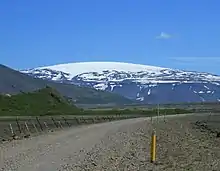
Eiríksjökull (Icelandic for "Eirík's glacier", Icelandic pronunciation: [ˈeiːriksˌjœːkʏtl̥] ⓘ) is a glacier north-west of Langjökull in Iceland, with an area of 22 km2 (8.5 sq mi) reaching a height of 1,675 m (5,495 ft),[1] making it the largest table mountain in Iceland.[2] Rising over 1,000 m (3,300 ft) above its surrounding, the lowest 350 m (1,150 ft) of a hyaloclastite (móberg) tuya formed presumably by a single subglacial volcanic activity is capped by a 750 m (2,460 ft) thick lava shield.[2][3] It is currently dormant or extinct in terms of volcanic activity.[4]
Etymology
The glacier was called Baldjökull until about 1700 and with relative certainty the current name is influenced by the nearby mountain Eiríksgnípa. Nothing is known with certainty about said Erik but a fable tells of an outlaw named Eiríkur or Eirekur who evaded capture by running into that mountain.[5]
References
- ↑ National Land Survey of Iceland (Icelandic)
- 1 2 Thordurson, Thor; Hoskuldsson, Armann (2002). Classic Geology in Europe 3: Iceland. Harpenden, England: Terra Publishing. p. 161. ISBN 1-903544-06-8.
- ↑ Einarsson, Þorleifur (2005). Geology of Iceland. Mál og menning. p. 76. ISBN 9979-3-0689-0.
- ↑ skimountaineer.com - Eiríksjökull
- ↑ "Hver var Eiríkur sá sem gaf Eiríksjökli nafnið sitt?".
64°46′24″N 20°24′34″W / 64.77333°N 20.40944°W